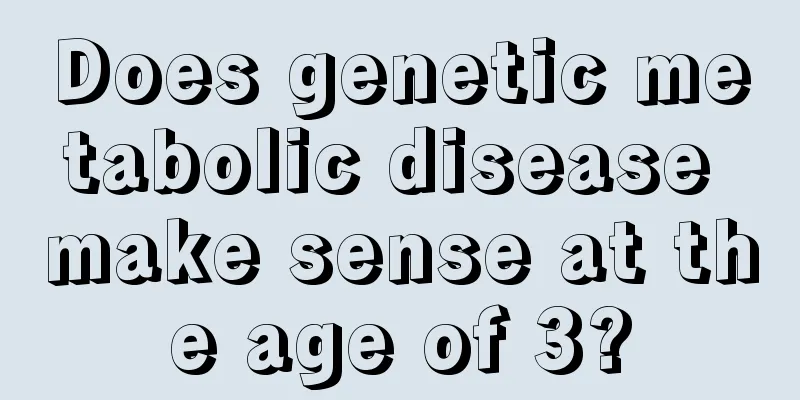Does genetic metabolic disease make sense at the age of 3?

|
Genetic metabolic diseases are a type of disease that are very harmful. Patients will experience different symptoms, such as severe vomiting, severe diarrhea, etc., and will also cause many neurological diseases. There is currently no completely effective treatment for genetic metabolic diseases. Patients can control them by supplementing necessary substances. So, if a three-year-old child has a genetic metabolic disease, is there any point in clinical treatment? Does genetic metabolic disease make sense at the age of 3? The manifestations of inherited metabolic diseases vary, including convulsions, hypotonia, and intellectual and motor development disorders. In addition, there may be various deformities such as special facial features, skin and hair, limb appearance and other abnormalities. These children should undergo blood chromosome screening, blood and urine amino acid screening, genetic diagnosis, etc. Even if there is a genetic metabolic disease, early intervention can have a different effect. The following is an example of the effectiveness of early intervention for a child with Angelman syndrome. Angelman syndrome, also known as Angelman Syndrome (AS), is caused by a gene defect. Known inheritance mechanisms include maternal 15q11-13 deletion, paternal uniparental disomy, imprinting center defects, and point mutations or small deletions in ubiquitin protease genes. The incidence of AS is 1/40,000 to 1/10,000, and there are approximately 15,000 patients worldwide. The clinical features of AS are developmental delay, distinctive appearance, paroxysmal laughter, ataxia, seizures and lifelong language defects. There is currently no effective cure for AS patients, and they can only improve their motor and language intelligence through rehabilitation training. In July 2012, the Baolan Baby Early Intervention Center admitted a one-year-old girl who came to the clinic because she could not roll over or sit, had few utterances, and had poor reactions to the outside world. The child has an abnormal face, never cries, always smiles, and has abnormally fair skin. AS is suspected and a genetic test is recommended. The results of genetic examination showed a deletion of band 1 and subband 2 in region 1 of the long arm of chromosome 15, confirming AS. After the child was diagnosed, rehabilitation training began. First, the children are tested for Peabody and developmental quotient, and their clinical characteristics are analyzed, and then a reasonable training plan is developed. During the training period, the program can be adjusted at any time according to the child's response and progress. Follow-up visits are conducted at regular intervals to conduct overall motor, intellectual, and language assessments to set the next training goal and a more comprehensive rehabilitation plan. After rehabilitation training, the child's condition improved significantly. The child will consciously call mom and dad at 20 months, and will walk independently at 2 years and 2 months. Now he is 3 years and 2 months old. He can walk steadily, hop on both feet, understand simple words, follow some simple instructions, and speak short sentences of 3-5 words. |
>>: How many months can a pacifier be used?
Recommend
What to do if your child has repeated coughs and fevers
Many times in the process of parenting, we will e...
Children's toenails are layered, or?
Our nails are normally pink and rosy, but if ther...
Children's common summer diseases "strategy"
Upper respiratory tract infection The rising temp...
Why do children get scared when sleeping?
When children are young, they sleep with their pa...
The child has a lump on his neck that will slide
Lymph nodes are very important in the human body....
Hand, foot and mouth disease recipes
Hand, foot and mouth disease is contagious, so tr...
Why do children keep clearing their throats?
As children grow up day by day, mothers are very ...
Does a one-year-old osteophyte fracture require surgery?
For a one-year-old child, the body is very fragil...
What to do if your baby has a persistent low-grade fever
If the baby has a low-grade fever that won't ...
Can babies eat black fungus?
Wood ear vegetable is actually a commonly consume...
What should children eat to nourish their stomachs?
Children are a relatively special group. Every me...
Do 4-month-old babies need calcium supplements?
When the baby is four months old, it is the right...
Do newborn babies need to take a bath every day?
Newborn babies do not need to be bathed every day...
How to treat rickets in babies?
Children are the treasures of the family. When a ...
Child's ears smell
It is quite common for children to have smelly ea...









